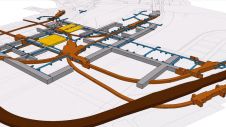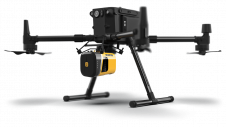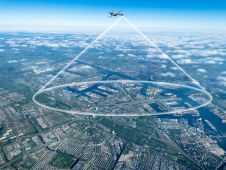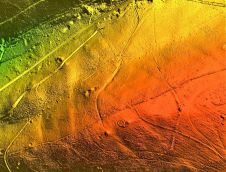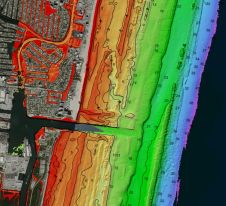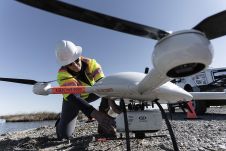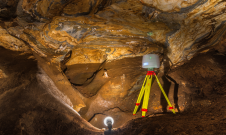UAS and Flooding
监测洪水和评估捷克共和国的损害
Heavy rainfall in late May and early June 2013 caused the Elbe, Vltava and Kamenice rivers to burst their banks in the Czech Republic. Among other areas, the Troja area of Prague and the villages of Hrensko and Nové Kopisty were severely flooded. Here, the author describes the experiences gained by the Czech company Geodis while using UAS technology to monitor and assess the impact of floods for the first time. Having proved that it can provide geodata quickly, cheaply and efficiently, UAS is now attracting significant interest from authorities.
| Figure 1, MD4-1000 from microdrones. |
Geodis is the producer of the countrywide orthoimagery, resolution 12.5cm, and the Digital Elevation Model (DEM), with grid spacing of 10m, of the entire Czech Republic. The revision cycle of both products is three years. The company has monitored large-scale floods in the Czech Republic since 1997 – mainly by traditional airborne photogrammetry, up until 2013. Products derived from overlapping aerial imagery such as georeferenced orthomosaics, DEMs, flood levels and maps of waterways support water boards, municipalities and other authorities in taking flood prevention measures and in decision-making when flooding has occurred.
UAS所有权
Since 2012, Geodis is the owner of two types of UAS: the quadrocopter MD4-1000 (Figure 1) from the company microdrones and an octocopter developed in-house (Figure 2). Both systems are equipped with GNSS, gyroscopes, accelerometers and compasses. They are used in a variety of projects which are often carried out in co-operation with research institutions and universities. The MD4-1000, equipped with a Canon EOS 5D Mark III, has a maximum speed of 12m/s, can stay airborne for 25 minutes, weighs 6.2kg with sensor on board and can carry a load of up to 1.5kg. The 22MP Canon camera contains a high-quality chip and is able to capture HD video. The octocopter developed in-house has a maximum speed of 15m/s, can stay airborne for 15 minutes with the above-mentioned Canon EOS 5D Mark III on board, weighs 9.5kg and can carry a load of up to 6kg. The ability to carry a relatively large and heavy payload of 6kg is advantageous for capturing inaccessible areas with a pallet of sensors, including thermal infrared sensors and multispectral and professional cameras. Other features include retractable legs and a remote-controlled
| Figure 2, Geodis Geocopter G8. |
无线连接到显示器的相机,从而使操作员可以实时遵循飞行。摄像机围绕三个轴的旋转可以由操作员指导,并允许动态镜头直接传输给当局以进行决策。可以通过遥控器来指导八摩托手的飞行路径,或者在飞行计划中预先指定。
洪水监测
洪水对当地的环境产生重大影响ronment and the people living there. In the case of a flood, authorities need information on the extent of the flooding, its rate of expansion or contraction, the number of people in the endangered areas, their ages and their addresses. Is anyone injured or dead, do they need medical care, should basic necessities be distributed? Important decisions to be taken include whether to evacuate people, their livestock and possessions to higher ground, or whether to inundate sparsely populated lowlands upstream in order to bring relief to densely populated areas. The process of collecting information may be severely hindered by inaccessibility of the area. Meanwhile, citizens may want to be kept informed about the situation by television channels and the internet. For some rescue tasks, information gained through human observations alone may suffice. Other tasks require calculations and the newly collected data to be combined with existing maps and DEMs; in other words, the imagery should have a high spatial resolution and be rectified and georeferenced. Fortunately, today’s photogrammetric software allows automatic generation of orthomosaics and DEMs to become available soon after the imagery has been recorded.
Taking Action
When flooding was threatening the river areas in the north western part of the country in late spring 2013, mobile mapping systems, manned aircrafts and UAS were deployed to collect geodata both from the ground and from the air. The use of UAS for monitoring such floods was new
| 图3中,布拉格:淹没动物园()和Troja Castle. |
对于捷克共和国而言,事实证明非常有价值。被洪水泛滥的地区的程度相对较小,使使用UAS易于覆盖。例如,必须在布拉格河上进行监测的区域仅测量1公里(图3)。视频设施允许位于被洪水淹没地点或危机中心附近的专家进行瞬时视觉检查。国家电视网络还记录并编辑了视频图像,以通知公众。为了创建正瘤,DEM和立体声视图,拍摄重叠的图像在60m的高度上拍摄,导致地面采样距离(GSD)为1厘米。沿轨道的重叠率为80%,整个轨道为60%。为了准确的地理发射目的,测量或从现有的地质蛋白研究库中测量地面控制点。由此产生的正瘤的GSD为3厘米,而DEMS的GSD为10厘米。
Inaccessible
由于UAS可以在低海拔地区飞行,因此在存在连续的雨水和云覆盖面的情况下,它可以捕获被洪水泛滥的地点。在相同的条件下,不可能由载人直升机或飞机进行的传统空中调查。这些系统很容易便携,可以简单而便宜地将其运送到洪水地点。除此之外,他们的经济高效运营以及他们可以在现场进行一次运营做好准备的事实,捷克当局对在危机情况下使用UAS技术表现出极大的兴趣也就不足为奇了。
Hřensko, a village located close to Germany at the confluence of the River Kamenice with the Elbe, was completed surrounded by water and almost the entire population was evacuated, although a dozen or so people refused to leave their homes (Figure 4). Regular UAS recording of this completely isolated village was the only way to monitor the extent of the flooding and to assess the steadily increasing damage.
另一个无法接近的村庄是NovéKopisty,它位于埃格河流入易北河的飞机上。大坝故障在整个村庄周围造成了一个大湖泊,将其与周围的环境隔开。村庄的洪水必须撤离。在这里,UAS
Figure 4, Hřensko, situated at the confluence of the River Kamenice with the Elbe. |
proved to be an excellent tool for monitoring inaccessible terrain and for providing emergency services and electronic media with aerial images, videos and orthoimagery very rapidly.
Permits
All UAS surveys have to be registered at the Civil Aviation Authority (CAA). The various types of UAS are categorised according to their weight and usage. The weight categories are: up to 0.91kg, 0.91-7kg, 7-20kg, and above 20kg. The two types of use are recreational/sport and commercial/research. Registration is compulsory for both. The UAS should always be in line of sight of the pilot who should be licensed.
总结说
UAS技术不仅可以收集准确,及时的地理达塔,而且还可以帮助寻找失踪人员并保护商店,企业和房主免受商品非法拨款。
使您的收件箱更有趣。Add some geo.
Keep abreast of news, developments and technological advancement in the geomatics industry.
免费注册














